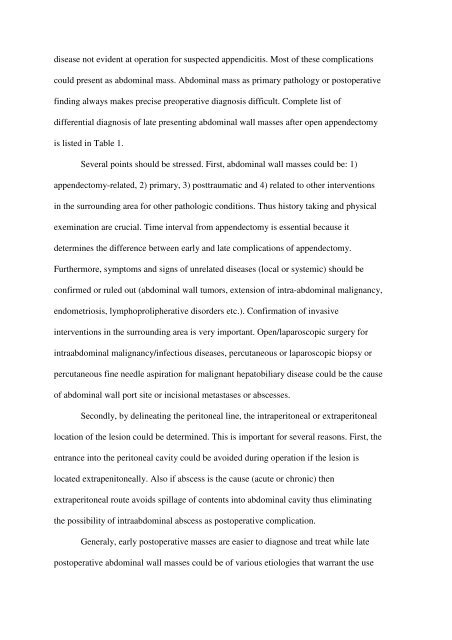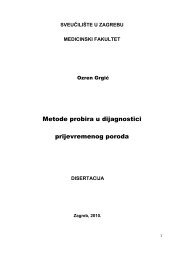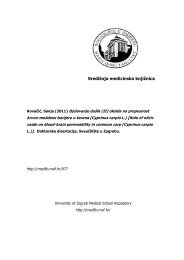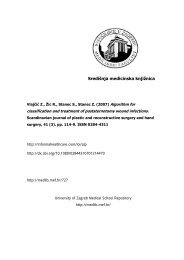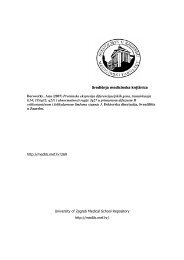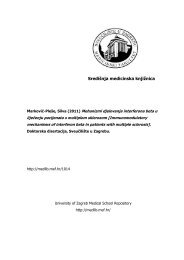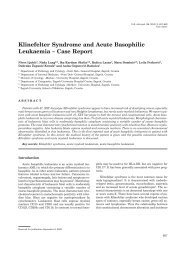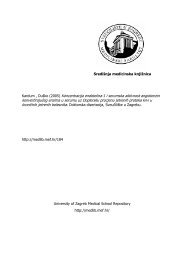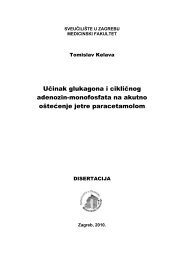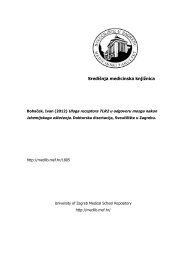Suture granuloma of the abdominal wall with intra-abdominal ...
Suture granuloma of the abdominal wall with intra-abdominal ...
Suture granuloma of the abdominal wall with intra-abdominal ...
Create successful ePaper yourself
Turn your PDF publications into a flip-book with our unique Google optimized e-Paper software.
disease not evident at operation for suspected appendicitis. Most <strong>of</strong> <strong>the</strong>se complicationscould present as <strong>abdominal</strong> mass. Abdominal mass as primary pathology or postoperativefinding always makes precise preoperative diagnosis difficult. Complete list <strong>of</strong>differential diagnosis <strong>of</strong> late presenting <strong>abdominal</strong> <strong>wall</strong> masses after open appendectomyis listed in Table 1.Several points should be stressed. First, <strong>abdominal</strong> <strong>wall</strong> masses could be: 1)appendectomy-related, 2) primary, 3) posttraumatic and 4) related to o<strong>the</strong>r interventionsin <strong>the</strong> surrounding area for o<strong>the</strong>r pathologic conditions. Thus history taking and physicalexemination are crucial. Time interval from appendectomy is essential because itdetermines <strong>the</strong> difference between early and late complications <strong>of</strong> appendectomy.Fur<strong>the</strong>rmore, symptoms and signs <strong>of</strong> unrelated diseases (local or systemic) should beconfirmed or ruled out (<strong>abdominal</strong> <strong>wall</strong> tumors, extension <strong>of</strong> <strong>intra</strong>-<strong>abdominal</strong> malignancy,endometriosis, lymphoprolipherative disorders etc.). Confirmation <strong>of</strong> invasiveinterventions in <strong>the</strong> surrounding area is very important. Open/laparoscopic surgery for<strong>intra</strong><strong>abdominal</strong> malignancy/infectious diseases, percutaneous or laparoscopic biopsy orpercutaneous fine needle aspiration for malignant hepatobiliary disease could be <strong>the</strong> cause<strong>of</strong> <strong>abdominal</strong> <strong>wall</strong> port site or incisional metastases or abscesses.Secondly, by delineating <strong>the</strong> peritoneal line, <strong>the</strong> <strong>intra</strong>peritoneal or extraperitoneallocation <strong>of</strong> <strong>the</strong> lesion could be determined. This is important for several reasons. First, <strong>the</strong>entrance into <strong>the</strong> peritoneal cavity could be avoided during operation if <strong>the</strong> lesion islocated extrapenitoneally. Also if abscess is <strong>the</strong> cause (acute or chronic) <strong>the</strong>nextraperitoneal route avoids spillage <strong>of</strong> contents into <strong>abdominal</strong> cavity thus eliminating<strong>the</strong> possibility <strong>of</strong> <strong>intra</strong><strong>abdominal</strong> abscess as postoperative complication.Generaly, early postoperative masses are easier to diagnose and treat while latepostoperative <strong>abdominal</strong> <strong>wall</strong> masses could be <strong>of</strong> various etiologies that warrant <strong>the</strong> use


